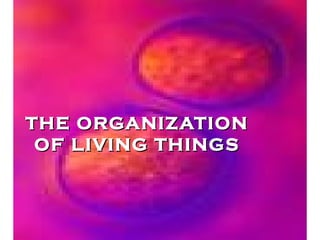The organization of living things
•Download as PPT, PDF•
1 like•14,111 views
Report
Share
Report
Share

Recommended
More Related Content
What's hot
What's hot (20)
Characteristics and classification of living organisms igcse o level 0610

Characteristics and classification of living organisms igcse o level 0610
Viewers also liked
Viewers also liked (20)
Similar to The organization of living things
Similar to The organization of living things (20)
Grade 4 Unit 3 Lesson 1 Plant & Animal Cells (1).ppt

Grade 4 Unit 3 Lesson 1 Plant & Animal Cells (1).ppt
S7Q2W7-Levels-of-Organization-and-Charat-of-Life-REV.ppt

S7Q2W7-Levels-of-Organization-and-Charat-of-Life-REV.ppt
More from jdrinks
More from jdrinks (20)
Recently uploaded
Recently uploaded (20)
Introduction to Multilingual Retrieval Augmented Generation (RAG)

Introduction to Multilingual Retrieval Augmented Generation (RAG)
Repurposing LNG terminals for Hydrogen Ammonia: Feasibility and Cost Saving

Repurposing LNG terminals for Hydrogen Ammonia: Feasibility and Cost Saving
CNIC Information System with Pakdata Cf In Pakistan

CNIC Information System with Pakdata Cf In Pakistan
How to Check CNIC Information Online with Pakdata cf

How to Check CNIC Information Online with Pakdata cf
Why Teams call analytics are critical to your entire business

Why Teams call analytics are critical to your entire business
AI+A11Y 11MAY2024 HYDERBAD GAAD 2024 - HelloA11Y (11 May 2024)

AI+A11Y 11MAY2024 HYDERBAD GAAD 2024 - HelloA11Y (11 May 2024)
The Zero-ETL Approach: Enhancing Data Agility and Insight

The Zero-ETL Approach: Enhancing Data Agility and Insight
Elevate Developer Efficiency & build GenAI Application with Amazon Q

Elevate Developer Efficiency & build GenAI Application with Amazon Q
Stronger Together: Developing an Organizational Strategy for Accessible Desig...

Stronger Together: Developing an Organizational Strategy for Accessible Desig...
AWS Community Day CPH - Three problems of Terraform

AWS Community Day CPH - Three problems of Terraform
"I see eyes in my soup": How Delivery Hero implemented the safety system for ...

"I see eyes in my soup": How Delivery Hero implemented the safety system for ...
Six Myths about Ontologies: The Basics of Formal Ontology

Six Myths about Ontologies: The Basics of Formal Ontology
Navigating Identity and Access Management in the Modern Enterprise

Navigating Identity and Access Management in the Modern Enterprise
JavaScript Usage Statistics 2024 - The Ultimate Guide

JavaScript Usage Statistics 2024 - The Ultimate Guide
Choreo: Empowering the Future of Enterprise Software Engineering

Choreo: Empowering the Future of Enterprise Software Engineering
The organization of living things
- 1. THE ORGANIZATION OF LIVING THINGS
- 2. BENEFITS OF BEING MULTICELLULAR • Larger Size: larger organisms are prey for fewer predators. Also, large predators can eat a wider variety of prey • Longer Life: not limited to the life span of any single cell • Specialization: each type of cell has a particular job. This makes the organism more efficient!
- 4. • Level 1: Cell • -smallest unit that can perform life processes independently • -vary in size and shape • -Example: plant cell (square) and animal cell (round)
- 5. LEVEL 2: TISSUE CELLS WORKING TOGETHER • Tissue: a group of cells that work together to perform a specific job Animals have 4 basic types of tissues: 1. nerve tissue
- 6. 2. muscle tissue 3. connective tissue
- 7. 4. Protective Tissue Example: Adipose (fat) cells in the skin
- 8. PLANT TISSUES • Plants have 3 types of tissue: 1. transport tissue 2. protective tissue (dermal) 3. ground tissue
- 9. LEVEL 3: ORGAN TISSUES WORKING TOGETHER • Organ = a collection of tissues that carry out a specialized function of the body • Example: heart - has mostly cardiac tissue, but also has nerve tissue and tissues of the blood vessels that all work together • Other examples: stomach, intestines, brain, and lungs
- 10. • Examples in plants: the leaf plant organ that contains tissue that traps light energy to make food • Also: stems and roots
- 11. IS THAT A FACT?! In your lifetime, your body will shed about 40 pounds of dead skin!
- 12. LEVEL 4: ORGAN SYSTEM ORGANS WORKING TOGETHER • Organ system = group of organs that work together to perform body functions • Examples: digestive system, which includes several organs, such as the stomach and intestines
- 13. ON ITS OWN: ORGANISM • Organism = a living thing; anything that can carry out life processes independently • An organism can be unicellular, like this bacteria:
- 14. • OR an organism can be multicellular, like you!
- 15. STRUCTURE & FUNCTION • In organisms, structure and function are related. Structure = arrangement of parts in an organization -Includes the shape of a part and the material of which the part is made Function = the job that the part does
- 16. EXAMPLE OF STRUCTURE AND FUNCTION: The structure of the lungs is a large, spongy sac. Blood vessels wrap around aveoli (air sacs). The structure of the aveoli and blood vessels enable them to perform a function, which is bring oxygen into the body and take out carbon dioxide.
- 17. REVIEW: 1. A ____________ is the most basic unit of all living things. 2. The job that an organ does is the _________ of that organ. 3. A group of cells working together to perform a specific function is a ______.
- 18. ANSWERS: • 1. cell • 2. function • 3. tissue